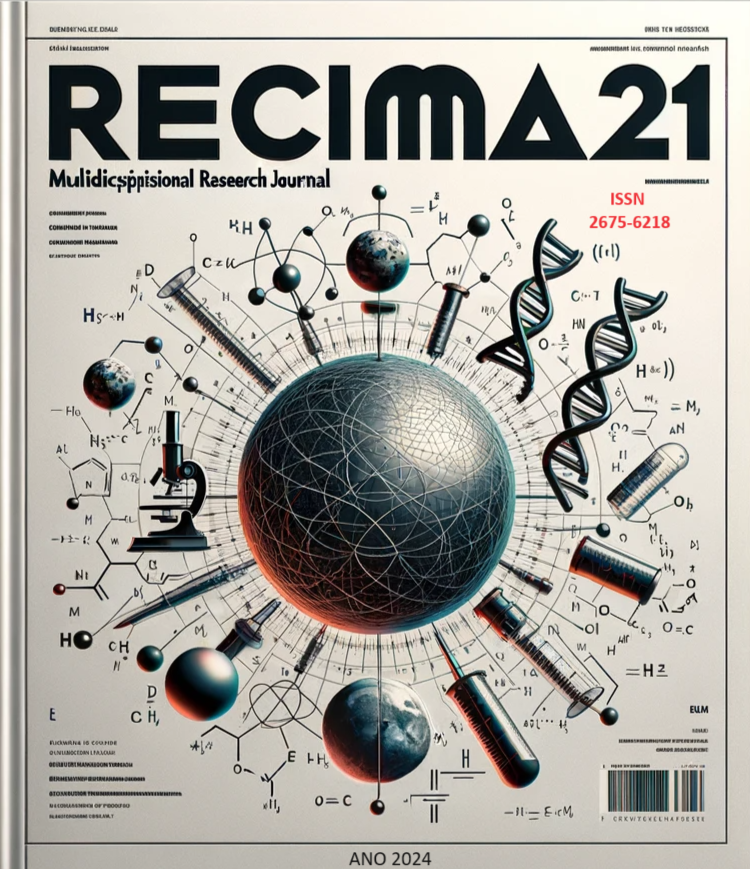OSTENSIBLE TRAFFIC POLICING AS A TOOL FOR CRIME PREVENTION AND REDUCTION IN THE CONTEXT OF THE DRY LAW IN URBAN TRAFFIC
DOI:
https://doi.org/10.47820/recima21.v5i9.5655Keywords:
Ostensible Policing in Traffic. Direction. Drunkenness. Prohibition.Abstract
This article is a bibliographical review of the literature on Ostensive Traffic Policing as a tool for preventing and reducing crime in the context of the Dry Law. It aims to understand the crime prevention and reduction tools related to the Dry Law, as well as the application of Ostensive Traffic Policing. Driving under the influence of alcohol is a risky behavior associated with a significant number of traffic accidents. Enforcement actions, administrative and criminal sanctions for drivers caught engaging in this behavior are adopted throughout the country. It is understood that Ostensive Traffic Policing is fundamental to preventing, combating and consequently reducing crime related to drinking and driving. In order to carry out the study, a bibliographic survey was carried out over the last 15 years (2009 to 2024) and 75 articles were found, 11 of which were selected for analysis, as they specifically covered Ostensive Traffic Policing, Dry Law and drunk driving. In addition to a documentary survey, the conceptual and legal aspects were identified, as well as the characterization of the Dry Law applied by ostensive traffic policing, which seeks to prevent and reduce the rates of drunk driving. It was concluded that there is a need for continued monitoring and education, because although the practice of abusive drinking and driving has reduced in Brazil, the practice.
Downloads
References
ABREU, D. R. DE O. M.; SOUZA, E. M. DE.; MATHIAS, T. A. DE F. Impacto do Código de Trânsito Brasileiro e da Lei Seca na mortalidade por acidentes de trânsito. Cadernos de Saúde Pública, v. 34, n. 8, p. e00122117, 2018. DOI: https://doi.org/10.1590/0102-311x00122117
ALMEIDA, N. D.; ROAZZI, A. Álcool e Direção em Universitários, Comunicação Persuasiva e Prevenção. Psicologia: Ciência e Profissão, v. 34, n. 3, p. 715-732, jul. 2014. DOI: https://doi.org/10.1590/1982-3703000632013
ASSOCIAÇÃO BRASILEIRA DE EDUCAÇÃO NO TRÂNSITO - ABETRAN. Álcool e Trânsito, uma mistura perigosa. [S. l.]: ABETRAN, 2017.
BRASIL. Código de Trânsito Brasileiro e Legislação Complementar em vigor. Brasília, D.F: Departamento Nacional de Trânsito, 2005.
BRASIL. Constituição (1988). Constituição da República Federativa do Brasil. Brasília: Senado, 1988. Disponível em: http://www.planalto.gov.br/ccivil_03/constituicao/constituicao.htm. Acesso em: 15 ago. 2024.
BRASIL. Decreto 6.117. Brasilia: Casa Civil, 2007b. Disponível em http://www.planalto.gov.br/ccivil_03/_Ato2007-2010/2007/Decreto/D6117.htm. Acesso em: 15 ago. 2024.
BRASIL. Decreto Lei n°667 de 2 de julho de 1969. Disponível em: http://www.planalto.gov.br/ccivil_03/decreto-lei/del0667.htm. Acessado em: 13 jun. 2011.
BRASIL. Lei nº 11.705, de 19 de junho de 2008. Altera a Lei nº 9.503, de 23 de setembro de 1997, que ‘institui o Código de Trânsito Brasileiro’, e a Lei nº 9.294, de 15 de julho de 1996. Diário Oficial da União [Internet] 20 jun. 2008. Disponível em: http://www.planalto.gov.br/ccivil_03/_ato2007-2010/2008/lei/L11705.htm.
BRASIL. Lei nº 9.503/1997 – Código de Trânsito Brasileiro. Brasilia: Planalto, s. d. Disponível em: http://www.planalto.gov.br/ccivil_03/leis/L9503Compilado.htm. Acesso em: 15 ago. 2024.
BRASIL. Lei nº Lei n° 14.229/2021. Brasília, DF: CTB. 2003.
BRASIL. Lei Seca no Brasil panorama dos últimos 15 anos. Brasília: Secretaria Nacional de Trânsito (SENATRAN), 2023. Disponível em: https://www.gov.br/transportes/pt-br/assuntos/noticias/2023/imagens/relatorio_15anos_leiseca.pdf. Acesso em: 15 ago. 2024.
BRASIL. Resoluções do CONTRAN. Brasilia: Departamento Nacional de Trânsito, 2007a. Disponível em: http://www.denatran.gov.br/resolucoes.htm. Acesso em 16 ago, 2024.
COSTA, T. M. M.; ARAÚJO, R. M.; GUERRA, L. C. B. Política Nacional sobre o Álcool - Lei Seca: Uma avaliação no Contexto da Polícia Militar. HOLOS, v. 3, p. 1–19, 2020. https://doi.org/10.15628/holos.2020.8457. DOI: https://doi.org/10.15628/holos.2020.8457
GUIMARÃES, M. A.; CARVALHO, C. C. F. A atuação do policial militar frente à embriaguez delituosa no trânsito. RHM - Revista Científica de Pesquisa em Segurança Pública, v. 10, 2013. Disponível em: http://revistacientifica.pm.mt.gov.br/ojs/index.php/semanal/article/view/211/0. Acesso em: 13 ago. 2024.
LAZZARI, C. F.; WITTER, Rosa, I. Nova Coletânea de Legislação de Trânsito. 23. ed. Porto Alegre: Sagra e Luzzatto, 2004.
MALTA, D. C. et al. Consumo de Bebidas Alcoólicas e direção de veículos, balanço da Lei Seca, Brasil 2007 a 2013. Revista de Saúde Pública, São Paulo, v. 48, n. 4, ago. 2014.
MINAYO, M. C. The inclusion of violence in the health agenda: Historical trajectory. Ciência e Saúde Coletiva, v. 11, n. 2, p. 375-383, 2006. DOI: https://doi.org/10.1590/S1413-81232006000200015
NASCIMENTO, A. DOS S.; GARCIA, M. L. T. Álcool e direção: uma questão na agenda política brasileira. Psicologia & Sociedade, v. 21, n. 2, p. 213–222, maio 2009. DOI: https://doi.org/10.1590/S0102-71822009000200008
NASCIMENTO, A. S.; MENANDRO, P. R. M. Bebida Alcoólica e Direção Automotiva: Relatos de Policiais Militares Sobre a “Lei Seca”. Psicologia: Ciência e Profissão, v. 36, n. 2, p. 411-425, abr./jun. 2016. DOI: https://doi.org/10.1590/1982-370300067201
SANTIL, C. M. C.; LOBÃO, S. E. Fiscalização de Alcoolemia e Embriaguez de Trânsito pela PMDF. Revista Ciência & Polícia, v. 6 n. 2, 2020. Disponível em: https://revista.iscp.edu.br/index.php/rcp/article/view/289. Acesso em: 20 ago. 2024. DOI: https://doi.org/10.59633/2316-8765.2020.289
SILVA, R. M. O policiamento ostensivo de trânsito como ferramenta para prevenção e redução da criminalidade. Rev. Ordem Pública, v. 3, n. 1, 2010. Disponível em https://rop.emnuvens.com.br/rop/article/view/29. Acesso em: 16 ago. 2024.
WORLD HEALTH ORGANIZATION (WHO). Youth and road safety. Genebra: WHO, 2007. Disponível em: http://whqlibdoc.who.int/publications/2007/9241595116_eng.pdf. Acesso em: 08 ago. 2024.
Downloads
Published
How to Cite
License
Copyright (c) 2024 RECIMA21 - Revista Científica Multidisciplinar - ISSN 2675-6218

This work is licensed under a Creative Commons Attribution 4.0 International License.
Os direitos autorais dos artigos/resenhas/TCCs publicados pertecem à revista RECIMA21, e seguem o padrão Creative Commons (CC BY 4.0), permitindo a cópia ou reprodução, desde que cite a fonte e respeite os direitos dos autores e contenham menção aos mesmos nos créditos. Toda e qualquer obra publicada na revista, seu conteúdo é de responsabilidade dos autores, cabendo a RECIMA21 apenas ser o veículo de divulgação, seguindo os padrões nacionais e internacionais de publicação.


 Clique para ver detalhes
Clique para ver detalhes 









